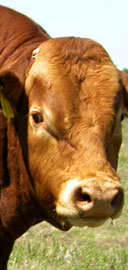Carcase Merit Index
The ‘Carcase Merit Index’ service is offered by ‘Natural Ecosystems Group’ (NEG), Albury, NSW, Australia
- Email: leonmartin@naturalecosystemsgroup.com
- Telephone: +61 2 6043 1328
- Mobile:+61 428 577 138
- Fascimile: +61 2 6043 2618
The use of live animal carcase scanning is not a new service, but not until the introduction of the ‘Carcase Merit Index’ system, which utilises the liveweight and scanning information and ranks an animal against other peers, did this information get put to best use.
The ‘Carcase Merit Index’ (CMI) is calculated for each animal, and is based upon the Live Weight(LW), Eye Muscle Area(EMA), Fat Depths(FD) and Intramuscular Fat(IMF) of the animals scanned.
Animals with heavy LW, large EMA, least FD and high IMF are rated highest by the ‘CMI’.
The results are presented in groupings by sex and age, and ranked from highest to lowest.
N.B. It is recommended that animals under the age of 24 months be divided into groups with up to a three month spread of age for the purpose of peer group comparisons.
In regard to ‘Carcase Merit Index’ standards, such standards are continually being updated from incoming data. At this stage, the following standards are offered for cattle as a guide,
- Eye Muscle Areas(EMAs) greater than 100 cm sq. for either sex and all ages excluding cattle under 6 months, is a very good result.
- Fat Depths measured on both the Rib and P8;Rump of >3mm and <10mm are ideal results for Domestic Trade cattle.
- Carcase Merit Index
| Bulls/Steers | Mature: (48 months) | > 3500 2700-3500 2000-2699 < 2000 |
– Super Elite – Elite – Standard – Sub Standard |
| Mature: (36 months) | > 3180 2430-3180 1800-2429 < 1800 |
– Super Elite – Elite – Standard – Sub Standard |
|
| Two Year Old: (24 months) | > 2660 1950-2660 1350-1949 < 1350 |
– Super Elite – Elite – Standard – Sub Standard |
|
| Yearling: (18 months) | > 2300 1600-2300 1000-1599 < 1000 |
– Super Elite – Elite – Standard – Sub Standard |
|
| 12 months | > 1525 1050-1525 680-1049 < 680 |
– Super Elite – Elite – Standard – Sub Standard |
|
| 6 months | > 750 500-750 340-499 < 340 |
– Super Elite – Elite – Standard – Sub Standard |
|
| Cows/Heifers | Mature: (48 months) | > 1750 1350-1750 1000-1349 < 1000 |
– Super Elite – Elite – Standard – Sub Standard |
| Mature: (36 months) | > 1580 1220-1580 890-1219 < 890 |
– Super Elite – Elite – Standard – Sub Standard |
|
| Two Year Old: (24 months) | > 1150 1040-1150 725-1039 < 725 |
– Super Elite – Elite – Standard – Sub Standard |
|
| Yearling: (18 months) | > 1150 900-1150 600-899 < 600 |
– Super Elite – Elite – Standard – Sub Standard |
|
| 12 months | > 775 600-775 400-599 < 400 |
– Super Elite – Elite – Standard – Sub Standard |
|
| 6 months | > 400 300-400 200-299 < 200 |
– Super Elite – Elite – Standard – Sub Standard |
The following comments are offered to assist you to interpret how livestock have rated on the Carcase Merit Index system:
Mature Bulls with a CMI result > 3100 is a very good result.
Two Year Bulls(24 months) with a CMI result > 2300 is a very good result.
Yearling Bulls(18 months) with a CMI result > 1950 is a very good result.
Young Bulls(12 months) with a CMI result > 1250 is a very good result.
Young Bulls(6 months) with a CMI result > 625 is a very good result.
Mature Cows with a CMI result > 1550 is a very good result.
Two Year Cows(24 months) with a CMI result > 1100 is a very good result.
Yearling Heifers(18 months) with a CMI result > 1025 is a very good result.
Young Heifers(12 months) with a CMI result > 690 is a very good result.
Young Heifers(6 months) with a CMI result > 350 is a very good result.
Mr Leon Martin has found great success in using the ‘Carcase Merit Index’ and scanning results as a marketing tool with bull/cattle buying clients. The ‘CMI’ together with scanning data, which is real data and not estimates, are very easily comprehended by buyers. Consequently, the CMI system is becoming increasingly popular with breeders as a marketing language/tool.
Working toward a better future for the Australian Livestock Producer and Meat Industry by measuring, and making a difference.
No more Guess Work!!
Maternal Index
At Weaning, all calves and their dams are weighed at the time.
Then, the data is divided into two groups for assessment and comparison – male calves and female calves.
Then, within the male and female groups, the liveweight of each calf is accounted against the age of the calf and then the subsequent performance of the calf accounted against the liveweight of each dam.
This assessment reflects on the dams ability to produce red meat, relative to her own body weight/size. It also, provide a very valuable insight into the merit of the different dam body sizes, and resultant efficiency of use of on farm resources.
Dams recording the highest ‘Maternal Index’ within each sex group are the best producing.











